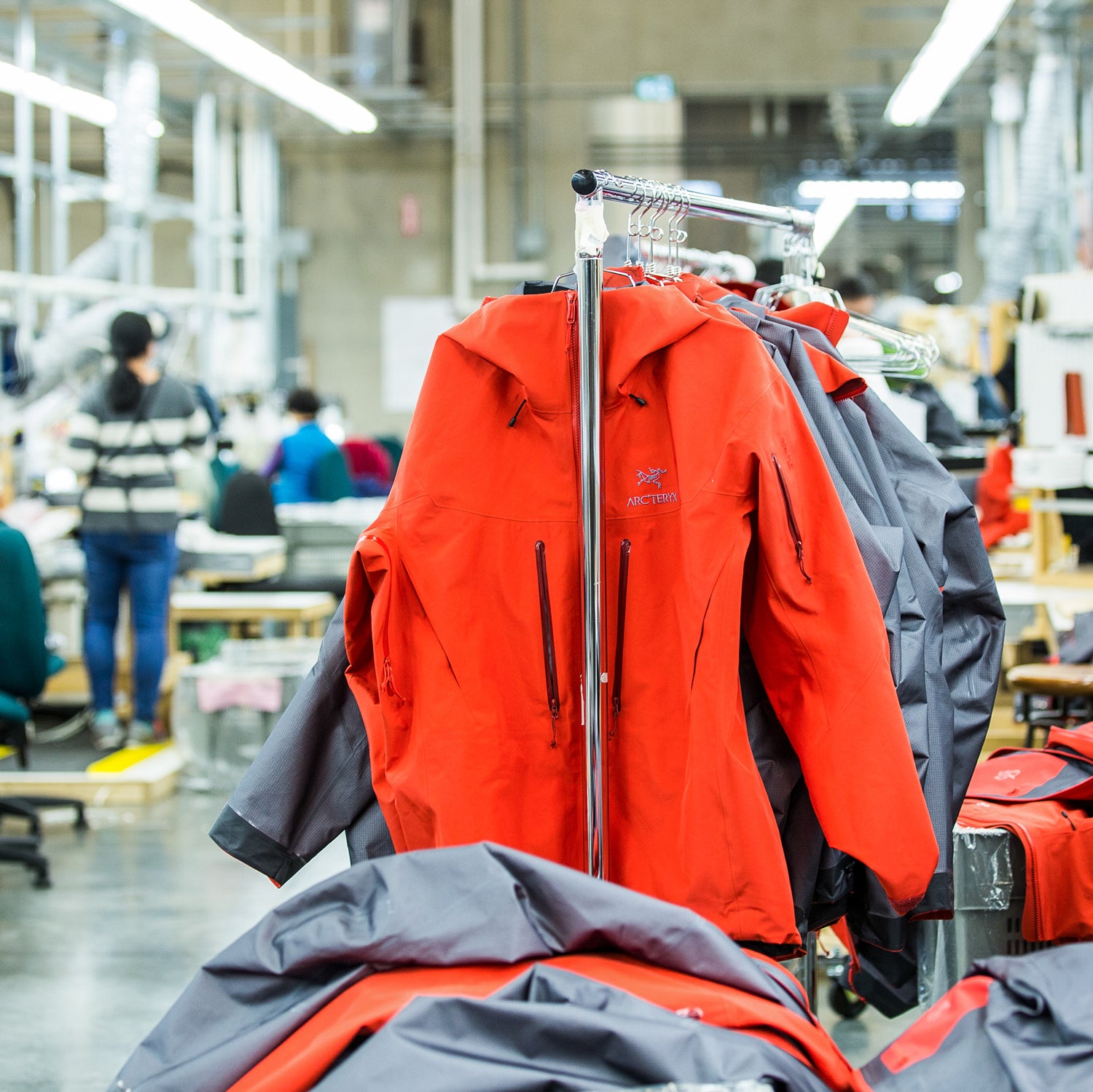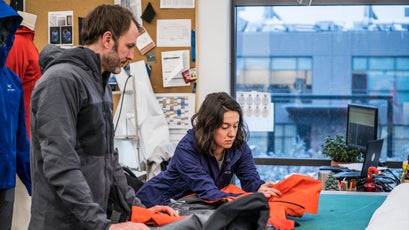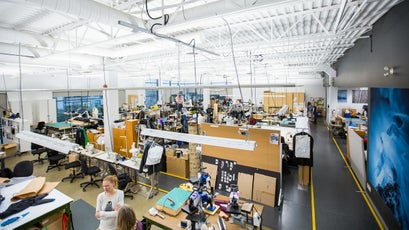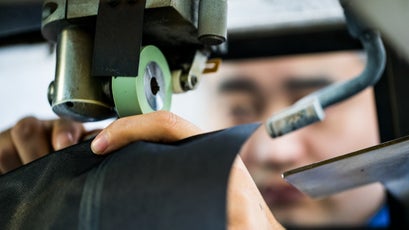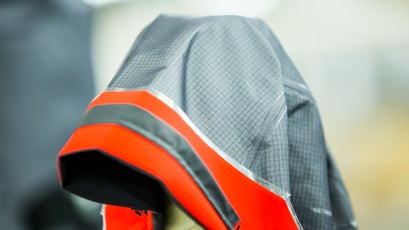It takes 259 minutes to construct each ��from start to finish��at in Vancouver.��It’s a 217-step process, which��includes��seven steps��on the hood brim alone. It’s so tricky in part because the jacket involves a��detailed mix of features��and Gore-Tex is��challenging��to work with. There aren’t any redos.��
In 2016, Arc’teryx design manager Greg Grenzke��and his team redesigned the Alpha SV, Arc’teryx’s flagship Gore-Tex shell, which has been around for 20 years and has a whopping $750 price tag. In the latest iteration, Grenzke��says the design team��found solutions to problems wearers��might never have considered, from the way that oils from sunscreen, sweat, and hair products break��down the jacket’s laminate to hem creep.��David Gardner, the ARC’One��training manager, says that an Alpha SV jacket takes twice as long to make as a comparable waterproof-breathable shell, and that’s not counting the time it takes to develop and design it.
I spent a day in Arc’teryx HQ talking with designers about the R&D and design process, then��following a jacket through the whole sewing and construction process��to find out what goes into making a $750 alpine climbing shell.��
Step 1: The Big Idea
The Alpha SV hadn’t been updated in five years, so��the first step was to complete a lifecycle analysis��looking at the environmental impact of the��jacket, from materials to manufacturing. Grenzke��says that he and his team��took things like recycled fabrics into account, but they decided their biggest impact was going to be designing a jacket that would last for a really long time. Longevity—both in terms of timeless design (“You want it to look good, and not out of date in five years,” he says) and tough material—was paramount.
Grenzke��has photos of all the Alpha SV’s past iterations lined up in a folder on his computer, and when you look at them in chronological order,��it’s like a game of telephone, where the message gets distorted the farther down the chain you move. The hood shape changes, the cut gets longer and slimmer, but the��main elements remain.��
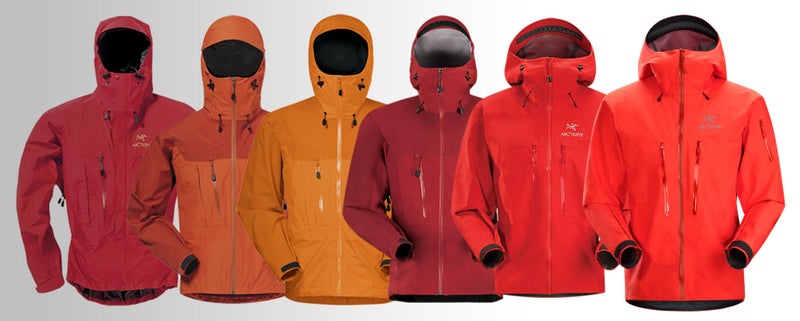
Grenzke��started a quarterly check-in with the warranty department��to see what problems customers were having with the jacket. He also reached out to local guides who spend 250 days a year in the original jacket. He learned where the jackets typically hinged and broke down, which is��how they learned about the oil contamination problem.��“Sweat breaks down the membrane, so you’ll get delamination of the back, which impacts breathability and waterproofing,” he says. To combat it, they decided to add a double layer of fabric around the neck.��
Once they’ve determined what their main goals are with the redesign, a product manager will create a design brief—a memo that��includes everything from the ideal user to price and weight targets.��
The brief then goes to the��desk of an apparel designer, someone like��Brylee Geddis, a wunderkind who was picked up by Arc’teryx right after graduating from fashion school. In her four years at Arc’teryx, she has helped refine the . She is also a ripping skier who grew up in Fernie, British Columbia, and knows what makes sense in the mountains.��Geddis has a sewing machine next to her computer, which she uses to rip apart old jackets and resew them so she can see where the seams might be hard to stitch��or where the fabric is used inefficiently. “Every new iteration has to be better than the old one,” she says.��
Step 2: Picking the Materials
When she gets the brief, Geddis’s first step is figuring out the best material to use. Though it may seem simple, this decision has the biggest bearing on how a piece will be used. For the updated Alpha SV, apparel��designers spent nearly a year testing different fabrics using a 1.5-hour-long mechanical��storm test in their lab��to validate waterproofing, plus��a particularly sweaty gear tester. They also sent the brand’s sponsored guides and athletes��out in test jackets that were Frankensteined together with left and right sides made of two different kinds of Gore-Tex to see how they held up and where they broke down.��Unlike some brands,��Arc’teryx��doesn’t develop any shell fabrics in-house, and instead licenses everything from Gore-Tex and invests its time in product design.
For the 2016��iteration of the Alpha SV, designers��upgraded the��face fabric from a lighter 80-denier Gore-Tex to a 100-denier��one. It seems like a small tweak, but Grenzke says it holds much less water. a problem they had with the older version.��“We always try to reduce the amount of water pickup, because once a jacket wets out it doesn’t breathe,” he says.
Step 3:��The Drawing Board
Once she's decided on a material, Geddis creates a design mockup—a detailed drawing of the final product. Then she and her five-person team map out what is essentially a recipe for a jacket: what trim will be used, which zippers, how they’ll seal the seams, etc. Geddis puts together a spec pack��of fabrics, the sample sewer makes a full prototype, and then they send everything to the ARC’One factory across town.��
Producing a complete product in Vancouver is more expensive than manufacturing it overseas. (About 10 percent of the company’s products are produced in the��two-year-old Canadian factory, while the rest are made in other international locations.)��But for a piece as technical��as the Alpha SV, the control the brand��has over the entire process makes the costs worth it. “The benefit of having the factory nearby is that if they have a part that’s difficult to construct, we can drive over there and work it out quickly and easily,” Geddis says. “We can make adjustments��and test them outside the next day.”��She says most products go through about three iterations before the team is��satisfied, but that she’s famous around the office for putting one��jacket through 12 rounds of prototypes.
As Geddis and her team pull the design together, they focus on how the jacket moves on people’s bodies—what happens when you raise your arms or swivel your head.��They start with simple, activity-specific��Gore-Tex fit blocks, which outline the general shape of the garment��and are based on fit-model sizing. Their fits have stayed consistent over the years. A men’s medium is 5 foot 10��with a 33.5-inch waist. A women’s small is 5 foot 6 with a 28-inch waist.
Then the team��adapts the pattern to fit the jacket’s intended use: something worn for climbing, for instance, will need more articulation through the sleeves.��The patterns are cut so your hood doesn’t block your eyes and you can reach above your head without exposing your middle.��Grenzke��notes that the way people layer has changed over the years so they take that into account��and think about how the jacket��might fit with different types of��midlayers.
Next they dial in the details. On the hood and hem, they decided to use , which are easy to adjust with gloves on. They also rethreaded the direction of the cord locks, so it goes up inside the jacket instead of down. This prevents the loops from getting stuck on things like ice axes, and it’s also wide enough��that it prevents the hem from riding up under packs and harnesses, a common problem that guides complained about.
From there��they take the design to the ARC’One��factory��to run through the whole production and see what might be hard to construct at scale and what steps they might be able to do more efficiently. By this point, they’ve been working on the redesign for almost two years.��
Step 4: Construction
Inside the 250,000-square-foot ARC’One factory, David Gardner, the training manager, breaks out a brick-thick binder for the Alpha SV, which outlines all the steps it takes to make the��jacket��in every size. Gardner says that each team can make about 30 jackets a day, and there are four teams that��work on the Alpha SV.��
The construction process starts when the fabric (usually��Gore-Tex and Polartec��products), arrives at the north end of ARC’One. There��it’s checked by a quality-control team, then rolled out onto giant cutting machines that slice pieces for four jackets at a time—that’s the optimum number to have move through the line at once, the company��says. From there all the parts, from pull tabs to seam tape, are put into one package, and they’re moved to the other end of the factory where they’ll be assembled.
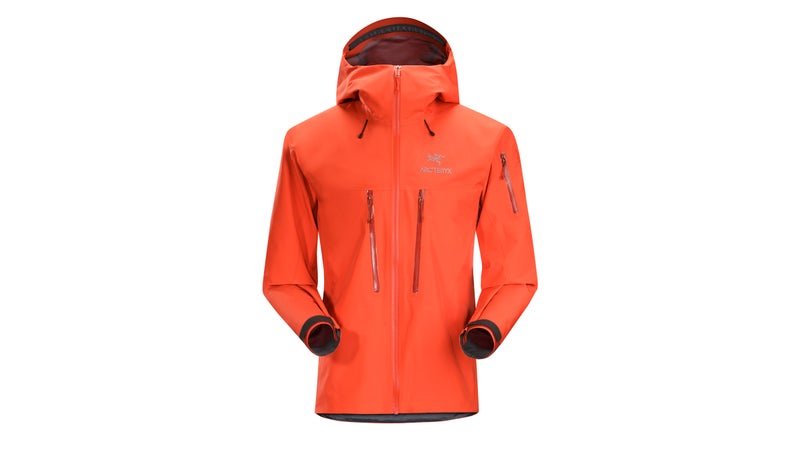
Gardner started here in 1998, the same year the first Alpha was manufactured, and says he’s had every job in the factory, from cutting fabric to teaching sewing. Over the years, he’s helped rearranged the factory and the process to be as efficient as possible. Everyone except the highly skilled��seam tapers does multiple jobs to keep things moving through the process, and they’ve set up the floor so there’s an obvious physical flow to the work. “I used to feel like I worked in a jacket factory. Now I feel like I work in a jacket lab,” he says.��
There are 13 people on each sewing team, and they sit in a horseshoe��lined by 26 sewing machines, seam tapers, and quality-control tests��stations including a water blaster that shoots a pressurized stream at the fabric to check its waterproofness. Building a jacket is like shingling a roof—there’s a specific order you have to follow when putting the��parts together. Every step and every minute has been thought out, but the final assembly, which takes 98 steps, feels almost��like a dance. Workers switch back and forth between sewing machines and glue guns, trading spots around the horseshoe. Seam taping is the hardest job,��so the most skilled person on the line stays on the seam taper, curving the external seams together. I sat down at the seam taper to try it out, and it took��me almost a full minute to tape one inch. The woman who works there can tape a sleeve in a matter of seconds.
Pieces of fabric that come to the horseshoe in a plastic bin become��a pocket, then a chest panel, then suddenly something that looks like a jacket. By the time it makes its way to the end of the horseshoe,��it’s completed, inspected, bagged, and tagged. All those hours of design distilled down into a pound of Gore-tex and glue.


